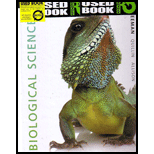
To review:
The correctness and incorrectness of the statement that the increase in the red blood cell count in tourists visiting Tibet is an example of acclimatization.
Introduction:
Acclimatization refers to the process in which an individual organism adapts to the changes in the environment such as a change in the temperature, altitude, pH (potential of hydrogen), or humidity.
Explanation of Solution
A short-term
Therefore, it can be concluded that the given statement is true.
Want to see more full solutions like this?
Chapter 42 Solutions
Biological Science
- In circulatory system, one the main function of our blood is controlling our body temperature. Explain further this : – Blood regulation fuctions is maintaining body temperature by absorbing amd distributing heat.arrow_forwardWhat are the physiological advantages in sport due to using erythropoietin? What are the physiological consequences of using erythropoietin? Give an example of a Professional Athlete that used erythropoietin (Armstrong does not count).arrow_forwardIn this lab exercise blood pressure at rest was to be compared against two different variable: 1) 2 minutes of exercise and 2) exposure to cold temperature. Explain the results shown below in terms of the physical effects these variables are having on the body: Blood Pressure at Rest/Room Temp Blood Pressure after 2 Minutes Exercise Blood Pressure after Cold Exposure 120/80 110/75 130/85arrow_forward
- Describe the conditions under which acclimatization occurs. Areacclimatizations passed on to a person’s offspring?arrow_forwardIn this lab exercise blood pressure at rest was to be compared against two different variables: 1) 2 minutes of exercise and 2) exposure to cold temperature. Explain the results shown below in terms of the physical effects these variables are having on the body Blood Pressure at Rest/Room Temp Blood Pressure after 2 Minutes Exercise Blood Pressure after Cold Exposure 120/80 110/75 130/85arrow_forwardAssume a person has been in a bad car accident and has severe bleeding from a partially severed arm. Describe the body’s response to this by answering the following What mechanisms will occur to reduce the blood loss l(hemorrhaging)? What events happen as part of the clotting process? How does the body slow down blood loss? What would happen if blood volume falls too low? What happens if homeostasis and blooarrow_forward
- Hemoglobin will bind oxygen and release CO2 in places where there is a higher concentration of O2, lower concentration of CO2, lower temperature and lower acidity (as it is in lungs) and will do the reverse – release oxygen and bind CO2 - in places where there is a lower concentration of O2, higher concentration of CO2, higher temperature and higher acidity (as it is in working muscles). True False While white blood cells never leave the circulation, red blood cells regularly leave it and travel by lymphatic system or find home in other tissues, e.g., lymph nodes, spleen, etc. True False Blood clotting (coagulation) is a complex process involving many factors and it exhibits positive feedback loops: many of the factors also stimulate production of their own precursors. B lymphocytes mature in the thymus while T lymphocytes mature in the bone marrow True False Antibodies are molecules on the surfaces of foreign…arrow_forwardList the function of acclimatization?arrow_forwardThe production of red blood cells is regulated by a feedback loop involving erythropoietin. In non-disease states, the production of red blood cells is equal to the destruction of red blood cells, thus maintaining sufficient red blood cells to deliver adequate oxygen to the body's tissues. However, when the number of red blood cells decrease and oxygen levels are low, erythropoietin is produced by the liver and kidneys to increase the production of red blood cells. (i) Is this a positive or negative feedback loop and why? (ii) For the above feedback loop, what would be the: 1. signal detected by the sensor: 2. effector: 3. response: 4. final result:arrow_forward
- An increased erythropoietin (EPO) output by the kidneys would lead to all of the following except Increased blood osmolarity Increased RBC production Increased blood viscosity Increased hypoxemia Increased hematocritarrow_forwardAt what point does blood lactate begin to accumulate and rise exponentially? 30% 40% 50% 60%arrow_forwardGlucose moves across capillary walls by: simple diffusion facilitated diffusion primary active transport secondary active transport Both C and Darrow_forward
 Human Physiology: From Cells to Systems (MindTap ...BiologyISBN:9781285866932Author:Lauralee SherwoodPublisher:Cengage Learning
Human Physiology: From Cells to Systems (MindTap ...BiologyISBN:9781285866932Author:Lauralee SherwoodPublisher:Cengage Learning


